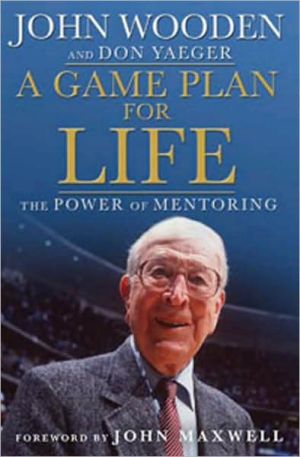Fine Young Man: What Parents, Mentors and Educators Can Do to Shape Adolescent Boys into Exceptional Men
From depression to dropping grades, from incidents of violence to teen suicide, today's adolescent boys are one of the largest at-risk groups in America today. In this bracing and insightful book, the bestselling author of The Wonder of Boys directs our attention to the unknown problems and marvels of this age group, helping parents and mentors shepherd boys through the challenging ages of ten to twenty.
Search in google:
As boys enter the second decade of their lives, they are confronted with tremendous challenges at home, at school, and in personal relationships. In a phenomenon long overlooked by the media and policy makers, adolescent boys are the most at-risk group in our society today, facing the highest incidence of addiction, violence, mental illness, and emotional neglect. Building on his pioneering work in The Wonder of Boys, Michael Gurian now explores the misunderstood life of the 90s male adolescent, providing parents and mentors with eye-opening and practical wisdom. Gurian answers tough questions about the changes boys face, focusing on new understandings of the hidden biology of the adolescent male; the development of emotional structure and social adaptation; the changing emotional safety within the family unit; necessary rites of passage; and the critical shifting in the attitude of society, educators, and the media in order to nurture adolescent boys into loving, wise, and responsible men. Giving us the tools to better nurture, discipline, and cultivate our adolescent males, Gurian delivers the most responsible and enlightening assessment of young manhood in our time. Publishers Weekly Carrying forward some of the themes first introduced in his book The Wonder of Boys (1996), Gurian focuses on male adolescence, a crucial stage of development that, he argues, is in crisis today, being both misunderstood and diminished in importance. Drawing on his own research and experience as a psychotherapist, he lays out a picture of male adolescence that is often bleak: adolescent males are four times as likely as females to commit suicide; only one out of six adolescents diagnosed with ADHD is female, and that 90% of adolescent discipline problems in schools are about males. The thrust of his approach, however, is proactive and ultimately imbued with hope. Gurian emphasizes the importance of family in the three distinct stages (transformation, determination and consolidation) of male adolescent development, which can begin as early as nine and extends through the early 20s. In the nurture/nature debate, Gurian falls somewhere in the middle, explaining and validating the importance of both male "hardwiring" (the genetic component) as well as emotional and cultural "softwiring." With persuasive eloquence, Gurian outlines thoughtful and practical steps parents and other caregivers can take to create the kind of positive role-models and nurturing support systems that will help boys successfully negotiate the passage to manhood. (July)
Introduction:\ Boys on Fire The Next Level Nature and Nurture: Adolescent Male Biology and Culture A Unique Opportunity\ Part One: The Emotional Lives of Adolescent Males\ Chapter One: Jason and His Brothers: What It's Really Like for Adolescent Boys in America\ Jason's Brothers The State of Male Adolescence Today:\ The Declining Safety of Our Adolescent Boys; The Mental Health of Adolescent Boys; Drugs, Alcohol, and the Depression Link; Suicide; Body Image; Attention Defecit Hyperactive Disorder (ADHD); Sexual Abuse Adolescent Males in the Educational System The Fragile Self Adolescent Male Self-Esteem Bravado and Beyond From Posturing to Trauma Responses Adolescent Male Posttraumatic Stress Adolescent Males in Shock\ Chapter Two: Protecting the Emotional Lives of Adolescent Boys\ The Emotional Neglect of Our Adolescent Boys Male Biology and the Adolescent Boy's Emotional Disadvantage:\ The Male Emotional System; Testosterone and the Emotional Disadvantage; The Deal; The Male Brain, Sexual Biology, and the Emotional Disadvantage; Philip The Key to Offsetting an Adolescent Boy's Emotional Disadvantage Resistance to Biological Teaching The Male Mode of Friendship Emotional Trauma, Emotional Neglect, and Your Adolescent Boy The Next Step\ Part Two: The Journey to Manhood: The Three Stages of Male Adolescence\ Chapter Three: The Crucial Passage: Nurturing the Second Decade of a Boy's Life\ Redefining the Purpose of Male Adolescence:\ A Brief History of Male Adolescence; The Core Self; The Second Birth; Adolescent Boys Need Clans The Masculine Nurturing System A Three-Stage Program for Raising Boys into Men The Value of Suffering\ Chapter Four: Stage 1: The Age of Transformation (Ages 9-13)\ Adolescence Can Begin at Nine Years Old The Formative Years What to Expect from a Prepubescent Adolescent Male:\ School Life; Peers; Emotions and Behavior; His Thinking Process, Including His Sense of Values What to Expect from Adolescent Boys During Puberty:\ Physiological Changes; More about Testosterone; The Emerging Adolescent Male's Brain What We Can Do to Raise Stage 1 Males into Exceptional Men The High and Low Ends of the Testosterone Scale Psychosocial Changes in Stage 1 Males:\ The Search for Identity; The Search for Autonomy; Autonomy and the Mother-Son Relationship; The Search for Morality; The Search for Intimacy The Stage 1 Rite of Passage\ Chapter Five: Stage 2: The Age of Determination (Ages 14-17)\ Myths about Stage 2 Youths What to Expect from Our Middle-Adolescent Males Cognitive Changes through Middle Adolescence What We Can Do to Raise Exceptional Middle-Adolescent Males When Does Aggression Become Violence?\ Which Middle Teen Behaviors Should We Really Worry About?\ The Teen Male Who Seems to Be Suffering and We Just Don't Know Why Psychosocial Development:\ The Search for Identity; The Search for Autonomy; The Search for Morality; The Search for Intimacy The Emergence of the Homosexual Adolescent Male Creating and Finding Rites and Rituals with Our Stage 2 Males:\ Family Rituals; The Stage 2 Rite of Passage: The Quest for the Self; The Vision Quest Model; Creating Your Own Vision Quest\ Chapter Six: Stage 3: The Age of Consolidation (Ages 18-21)\ What to Expect from a Stage 3 Adolescent The Warrior, the Artist, and the King:\ The Warrior; The Artist; The King The Meaningful Testing Ground Keepers of the Testing Ground Bruce's Story Psychosocial Development:\ The Search for Identity; The Search for Autonomy; The Search for Morality; The Search for Intimacy The Stage 3 Rite of Passage\ Part Three: Educating Adolescent Boys\ Chapter Seven: Schoolboys: Adolescent Boys and the Educational System\ Gender Ideologies and Our Educational Assessments Innovations for Educators: Different Ways Boys and Girls Learn Natural Nurturance Improving Sex Education After-School Programs Violence in the Schools Structural Solutions in Educational Systems:\ Single-Sex Classrooms; Boys' Schools The Politics Surrounding Single-Sex Education: Title IX Other Educational Innovations\ Chapter Eight: Virtual Masculinity: Adolescent Boys and the Media\ What Do We Know About Media Use?\ The Media Are Family Members How Children Bond with Media Figures How Storytelling Works Media Stimulation and the Brain:\ Hormones and the Media; Imprinting; Overriding Natural Neural Protections What First Families Can Do A New Vision\ Part Four: The Refining Fire: Caring for the Spirit of Our Young Men\ Chapter Nine: Nurturing the Core of Manhood\ New Models of Manhood The Core of Manhood Compassion: The Art of Compassionate Conversation Honor Responsibility Enterprise The Score Model\ Chapter Ten: The Ten Integrities\ Lineal Integrity Psychological Integrity Social Integrity Spiritual Integrity Moral Integrity Emotional Integrity Sexual Integrity Marital Integrity Physical Integrity Intellectual Integrity\ Epilogue Notes and References Index About the Author
\ From Barnes & NobleThe Barnes & Noble Review\ Our Boys, Ourselves: Why Adolescent Boys Are Freaking Out, and What We Can Do About It \ Dead-eyed schoolyard killers, slackjawed video-game addicts, rat-pack gang members dedicated to ritual violence and self-mutilation: The '90s sure are a great time to be a boy.\ Ignored and essentially stigmatized by decades of academic theory and gender revolution, boys are literally America's latest bete noire — 15 times as likely as girls to be victims of violent crime, 6 times as likely to be dosed with Ritalin, 4 times as likely to be diagnosed as mentally disturbed, 4 times as likely to commit suicide....\ The list goes on, but for therapist and manhood guru Michael Gurian, it's time to redirect our energies. Like a growing number of educators, researchers, and parents, Gurian, author of the bestselling The Wonder of Boys, feels that our recent hyperfocus on the troubles of adolescent girls has demonized boys, blaming them as the cause of female self-esteem problems, when it's really boys who are the sinking ships in our postmodern society.\ Gurian is certainly on to something, and his passion is contagious. He forcefully and, I think, fairly argues that any attempt to "reinvent" manhood, to groom away male traits such as aggression and love of hierarchy, is doomed to fail. But far from throwing out those early-'90s "problem girl" books, such as Reviving Ophelia and Failing at Fairness, he wants to supplement their lessons with suggestions on how to give boys the structure and guidance they need.\ The new studies quoted by Gurian (and citedapprovinglyby Mary Pipher, author of Revivin Ophelia) show that it is boys whose self-esteem plummets more deeply in adolescence, boys who are increasingly failing to graduate from high school and college, boys who are victims of violence or perpetrators of it. As our society moves into the endgame of the industrial revolution, adolescent males have been cut loose from any sort of structure — whether it be familial, clan, tribal, religious, or work-related. Subject to an average of seven testosterone washes a day beginning around age nine, boys are biologically in need of hierarchical structures, and the mentoring available within them, in order to learn self-knowledge and self-control. Without these structures, they become scared, fragile, numb, and capable of doing harm to themselves and others.\ So — to paraphrase the Rolling Stones' "Street Fighting Man" — what can a poor boy do (except sing in a rock 'n' roll band)? Gurian's book details the three stages of adolescence and comes up with an impressive set of frameworks for parents and educators to apply to the children with whom they come into contact. These guidelines are pragmatic, frequently combine cutting-edge science with the ancient truths of religion and anthropology, and seem neither too new age nor too repressive.\ I felt equal relief that Gurian also doesn't come off as an ideologue or woman-basher. For instance, I can't imagine too many feminists arguing against his goal of Stage 3 (ages 18 to 21) emotional maturity, which is that males be "developmentally ready to understand that adult love is love practiced like a spiritual discipline." Much to my loss, I had nobody to explain that to me at 21. But as a parent of a 12-year-old boy, I can see myself reaching for this book often over the next decade.\ Don Wallace is the author of a novel, HOT WATER, and of essays in Harper's, Parents, The New York Times, and other publications. Articles by Wallace appear in the current (July) issues of Redbook and Self.\ \ \ \ \ \ Publishers Weekly - Publisher's Weekly\ Carrying forward some of the themes first introduced in his book The Wonder of Boys (1996), Gurian focuses on male adolescence, a crucial stage of development that, he argues, is in crisis today, being both misunderstood and diminished in importance. Drawing on his own research and experience as a psychotherapist, he lays out a picture of male adolescence that is often bleak: adolescent males are four times as likely as females to commit suicide; only one out of six adolescents diagnosed with ADHD is female, and that 90% of adolescent discipline problems in schools are about males. The thrust of his approach, however, is proactive and ultimately imbued with hope. Gurian emphasizes the importance of family in the three distinct stages (transformation, determination and consolidation) of male adolescent development, which can begin as early as nine and extends through the early 20s. In the nurture/nature debate, Gurian falls somewhere in the middle, explaining and validating the importance of both male "hardwiring" (the genetic component) as well as emotional and cultural "softwiring." With persuasive eloquence, Gurian outlines thoughtful and practical steps parents and other caregivers can take to create the kind of positive role-models and nurturing support systems that will help boys successfully negotiate the passage to manhood. (July)\ \ \ Library JournalBeausay and Gurian are both clinical psychotherapists, previously published authors, and the fathers of boys. In their new works, they focus on the development of adolescent boys, sharing a concern for boys' complete growth--physical, spiritual, emotional, and religious--to adulthood. The books have different tones, however, and are directed at different audiences. Beausay addresses the parents of teenagers, assuring them that they will survive. Teenage Boys! is very upbeat with a flexible, not prescriptive, approach; suggestions are practical ideas for parents to try. Gurian's book is less a parenting book, although it will interest parents of adolescent boys, and more a work on adolescent male psychology. A Fine Young Man draws from biology, psychology, and sociology to paint a detailed picture of the tasks an adolescent boy needs to undertake to become a mature adult. Although the volume is somewhat scholarly in tone, no detailed bibliography is provided. Gurian helps his readers understand the teenager in depth, but his ideas are sometimes subject to challenge. Teenage Boys! is highly recommended for all parenting collections. A Fine Young Man is recommended for collections in adolescent psychology and larger parenting collections.--Kay L. Brodie, Chesapeake Coll., Wye Mills, MD\ \ \ \ \ Don WallaceJuly 1998\ Our Boys, Ourselves: Why Adolescent Boys Are Freaking Out, and What We Can Do About It\ Dead-eyed schoolyard killers, slackjawed video-game addicts, rat-pack gang members dedicated to ritual violence and self-mutilation: The '90s sure are a great time to be a boy.\ Ignored and essentially stigmatized by decades of academic theory and gender revolution, boys are literally America's latest bête noire -- 15 times as likely as girls to be victims of violent crime, six times as likely to be dosed with Ritalin, four times as likely to be diagnosed as mentally disturbed, four times as likely to commit suicide....\ The list goes on, but for therapist and manhood guru Michael Gurian, it's time to redirect our energies. Like a growing number of educators, researchers, and parents, Gurian, author of the bestselling The Wonder of Boys, feels that our recent hyperfocus on the troubles of adolescent girls has demonized boys, blaming them as the cause of female self-esteem problems, when it's really boys who are the sinking ships in our postmodern society.\ Gurian is certainly on to something, and his passion is contagious. He forcefully and, I think, fairly argues that any attempt to "reinvent" manhood, to groom away male traits such as aggression and love of hierarchy, is doomed to fail. But far from throwing out those early-'90s "problem girl" books, such as Reviving Ophelia and Failing at Fairness, he wants to supplement their lessons with suggestions on how to give boys the structure and guidance they need.\ The new studies quoted by Gurian (and cited approvingly by Mary Pipher, author of Reviving Ophelia) show that it is boys whose self-esteem plummets more deeply in adolescence, boys who are increasingly failing to graduate from high school and college, boys who are victims of violence or perpetrators of it. As our society moves into the endgame of the industrial revolution, adolescent males have been cut loose from any sort of structure -- whether it be familial, clan, tribal, religious, or work-related. Subject to an average of seven testosterone washes a day beginning around age nine, boys are biologically in need of hierarchical structures, and the mentoring available within them, in order to learn self-knowledge and self-control. Without these structures, they become scared, fragile, numb, and capable of doing harm to themselves and others.\ So -- to paraphrase the Rolling Stones' "Street Fighting Man" -- what can a poor boy do (except sing in a rock 'n' roll band)? Gurian's book details the three stages of adolescence and comes up with an impressive set of frameworks for parents and educators to apply to the children with whom they come into contact. These guidelines are pragmatic, frequently combine cutting-edge science with the ancient truths of religion and anthropology, and seem neither too new age nor too repressive.\ I felt equal relief that Gurian also doesn't come off as an ideologue or woman-basher. For instance, I can't imagine too many feminists arguing against his goal of Stage 3 (ages 18 to 21) emotional maturity, which is that males be "developmentally ready to understand that adult love is love practiced like a spiritual discipline." Much to my loss, I had nobody to explain that to me at 21. But as a parent of a 12-year-old boy, I can see myself reaching for this book often over the next decade.\ Don Wallace is the author of a novel,Hot Water, and of essays in Harper's, Parents, The New York Times, and other publications.\ \ \








